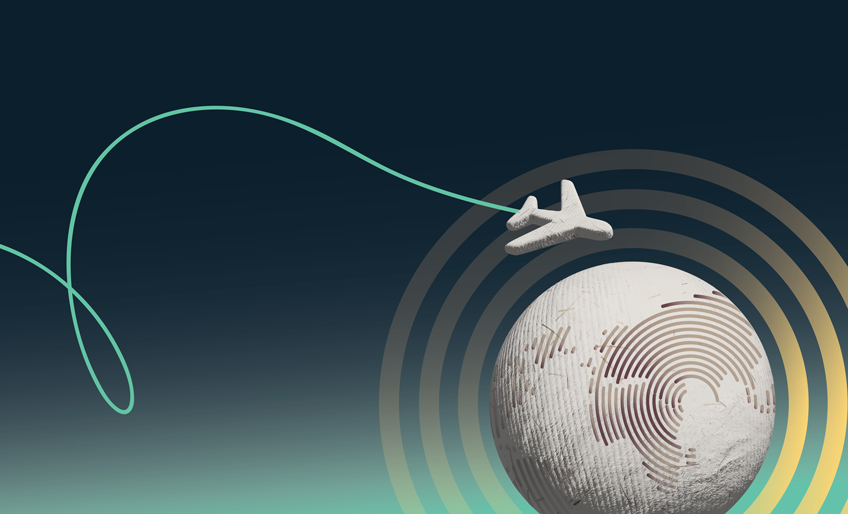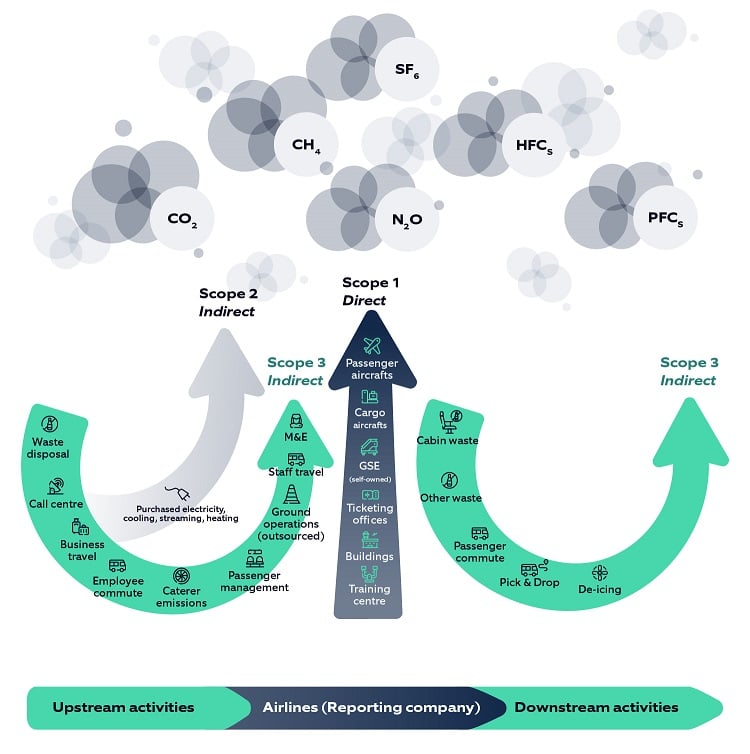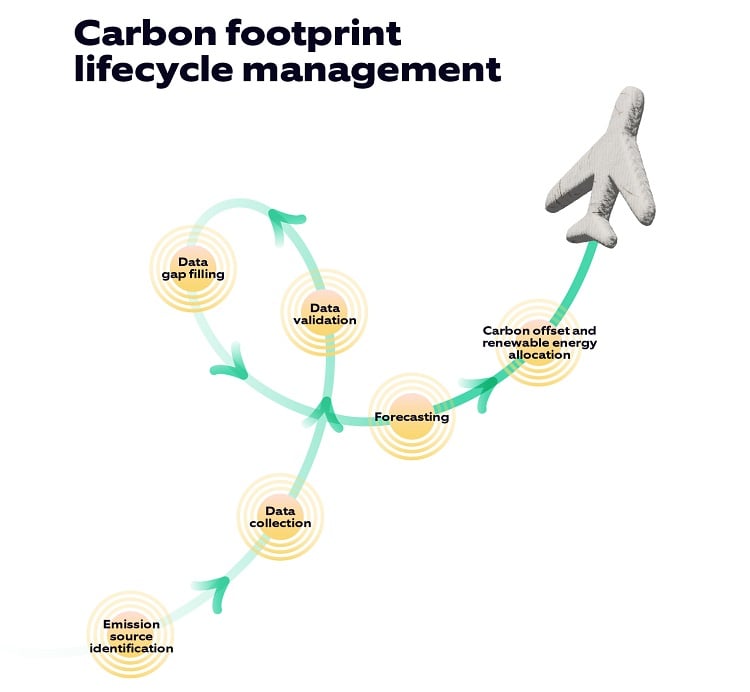Article 6 Jun 2022 6 min read
Are airlines already on the path to sustainability? Or is Net Zero a long way ahead?
Although airlines have started on their journey to net zero, it is easier said than done. The green airline is still a distant dream, even though the industry strives hard to move in this direction.

.png)
Although airlines have started on their journey to net zero, it is easier said than done. The green airline is still a distant dream, even though the industry strives hard to move in this direction.
.png)
As the impact of climate change becomes more apparent with each passing day, the airline industry, which accounts for about 3% of global carbon emissions, has made it a strategic priority to tackle sustainability challenges. In October 2021, the International Air Transport Association (IATA) approved a resolution to achieve net zero carbon emissions by 2050, aligning itself with the Paris Agreement. As per IATA's estimations, with approximately 10 billion people expected to fly in 2050, it may be challenging for the industry to achieve net zero emissions by the mid of this century.
While IATA has a concrete plan in place to achieve this target with Sustainable Aviation Fuel and more efficient airframe and propulsion technologies set to do the heavy lifting, for the airlines to be truly net zero, it is essential to look beyond these two factors. The need of the hour is to adopt a holistic approach across the entire aviation ecosystem. Airlines must create a comprehensive view of their emissions and start taking initiatives across the value chain for their reduction. They must understand their carbon footprint across Scope 1, Scope 2, and Scope 3 criteria as laid down under the GHG protocol and then establish a plan of action to achieve net zero.
 Figure1: Comprehensive view of Airline Scope 1, Scope 2, and Scope 3 emissions as per GHG guidelines
Figure1: Comprehensive view of Airline Scope 1, Scope 2, and Scope 3 emissions as per GHG guidelines
The above diagram illustrates the emissions across the airline value chain. There are several initiatives to reduce Scope 1 emissions (such as through the use of combustion jet fuel) and Scope 2 emissions (by opting for the use of renewable energy sources). Reducing Scope 3 emissions is still a grey area for airlines. Areas such as waste management and staff travel are vital areas contributing to Scope 3 emissions, but today, airlines are struggling to account for these factors.
Going all-in to achieve the net zero goal
With each passing day, climate changes are becoming scarier and also, more and more eco-conscious passengers are demanding to travel sustainably. Airlines today need to make bolder moves to achieve net zero, and we have defined a 3-pillar approach to help them:
Get control of your carbon footprint
The first fundamental principle to achieving net zero is for airlines to control the carbon footprint across their value chain. From direct to indirect sources and from owned/operated to supplier governed, airlines need to start tracking the carbon emissions generated across different operations and processes. This makes it crucial for airlines to track the lifecycle of carbon footprint generated across airline operations to understand the distribution, trends, and effectiveness of the measures taken to reach the net zero goal. We believe that the comprehensive process of understanding the Carbon Footprint life cycle will have the following steps:- Emission source identification: Identify and list down all the emissions sources across the airline value chain (Scope 1, Scope 2, and Scope 3). Create a mapping of the emission factor used to calculate the carbon footprint for the respective emissions source.
- Data collection: Track and collect resource utilization data, create energy use records as per fuel type, and model the carbon footprint records by converting energy uses into emissions.
- Data validation: Check for data accuracy, connect with different stakeholders to understand the process flow, and ensure that no detail is missed.
- Data gap filling: Identify the missing energy use records and fill in the gaps from actuals or through statistical computations.
- Carbon offsets and renewable energy allocation: Identify and record the offsets such as tree plantation initiatives, sustainable aviation fuel, renewable energy sources, and purchase of carbon credits.
- Forecasting: Forecast emissions and waste generation for the remaining part of the year based on historical data and industrial assumptions. This is basically a comparison of the targets set and the actual emissions/presumptions happening for the year. Makes it easy to visualize the targets and work accordingly.
Airlines can now set sustainability goals and measure their progress with this complete understanding. The data can be used to create dashboards to generate actionable insights for organizations to define their net zero initiatives. Going a step further, it will even ensure successful and faster carbon audits and help publish reports to raise awareness about efforts towards sustainability.
 Figure 2: Carbon footprint lifecycle management for airlines
Figure 2: Carbon footprint lifecycle management for airlines
Transform operations and supply chain
After airlines gain control of their carbon footprint by understanding the carbon lifecycle across operations, the next step is to decarbonize their operations and supply chain. There is considerable room to take up sustainability initiatives across the value chain, creating environmental impact and driving operational efficiency and cost benefits for airlines. Emerging technologies such as AI/ML, RPA and the metaverse provide the necessary fuel for airlines to transform their operations and supply chain.
While it is impossible to reduce carbon emissions across some of the operational processes, there are some areas where airlines can start acting immediately.
- Blending digital workforce personas across business functions
Creating digital personas for the crew, ramp agents, etc., to digitalize some of their operational tasks would help airlines achieve operational efficiency and add to their sustainability goals.
To explain how that is possible, let's take the example of crew members. One of their tasks is to share feedback on cleaning services, an activity that is still being done through paper checklists. Automating the process would help make an environmental contribution by reducing paper usage and help in a faster turnaround. Now, let's take the second example of the ramp agent responsible for marshaling aircraft. Connecting the ramp agent and providing all the details with just one click can significantly impact the taxiing time for aircraft, thereby saving precious fuel. - Managing cabin waste
Cabin waste essentially comprises two different types of waste—cleaning waste, which includes the leftover from the items given to passengers, such as towels, magazines, blankets, and catering (galley) waste, which consists of leftover food and drinks, packaging, etc. As per a study conducted by IATA, 23% of the total waste generated per passenger for a flight consists of untouched food and drink. This is another low-hanging fruit airlines can immediately pick that will help them reduce their carbon footprint and costs. For instance, a vision analytics-based solution could help airlines analyze the food consumption across the routes and then correspondingly optimize their food menu. - Incorporating predictive approaches across the value chain
Airlines are sitting on a data mine that is yet to be fully explored, and airlines need to start tapping into it to achieve net zero. By predictive modeling, airlines could estimate their wastes, better organize aircraft maintenance, and optimize their operations. For instance, airlines could reduce fuel wastage by predicting when an aircraft would be due for maintenance activities. Further on, airlines can even simulate the impact of maintenance activity on aircraft performance.
These are just some of the examples of the use cases from the vast universe of innovative approaches possible today by leveraging emerging technologies. By identifying and implementing them, airlines can create an environmental impact and take steps toward lean operations and supply chain.
Seek differentiation with eco-conscious passengers
Today, there is a new segment in the market—eco-conscious travelers. Undoubtedly, the first-mover advantage to capture the considerable market share for this segment would be applicable here as well. So, airlines' measures to reduce their carbon footprint can directly correlate with their revenue. It allows differentiating themselves from competitors and establishing an emotional connection with the passengers, further translating into loyal promoters for airlines. This helps raise the brand value for the airline and enables it to capture the market share at a premium price.
There is always the question of how premium pricing will be perceived in a price-sensitive market where airlines are competing for each penny. Well, to answer that, we can always take the inspiration from other industries, such as retail, where you will find fair trade products (where customers don't mind paying up to 15% premium) occupying more and more shelf space and eco-clothing options selling at a higher price for all brands.
According to a recent Ocado research, 64% of their customers say that it is important to include fair trade products in their shop and 22% reveal that they buy a fair trade product weekly, indicating a high intentional purchase of fair trade products in the UK market.
Suppose airlines incorporate an appropriate marketing strategy powered by the right tools such as CRM enabling segmentation and right targeting at the right time and across the right channel. In that case, we believe the first movers in this area have a strong chance to capture this budding market segment.
We, at Nagarro, bring in much-needed technological and domain capabilities to help airlines embrace the challenge of sustainability. To know more about how we can support you in your net zero journey, contact our experts at explore.tnl@nagarro.com.



